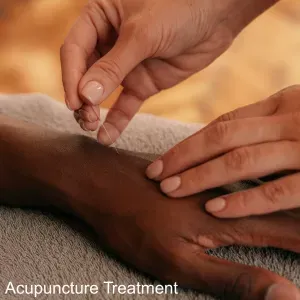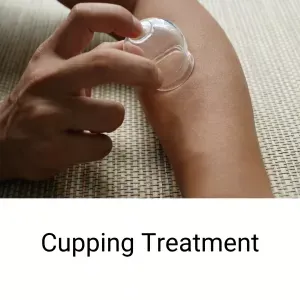By Qineng Tan, L.Ac., Ph.D. and Xiaomei Cal, L.Ac., Ph.D.

Fingers bent and can’t straighten? Dupuytren’s contracture is a condition in which the tissues under the skin of the fingers get thick and tight, making it hard to open your hand fully. Acupuncture and TCM offer alternative treatment for Dupuytren’s Contracture to help improve mobility in the fingers and hand.
Dupuytren’s Contracture is a progressive condition that causes the fingers—most often the ring and pinky fingers—to bend toward the palm, eventually interfering with hand function. Although it often develops slowly over several years, the impact on everyday activities can be significant.
What Is Dupuytren’s Contracture?
Dupuytren’s Contracture is a connective tissue disorder that affects the palmar fascia—the fibrous layer beneath the skin of the palm and fingers. Over time, this tissue thickens and shortens into tough, cord-like structures that gradually pull the fingers into a bent position.
This condition most commonly affects the ring and pinky fingers. While the condition is typically painless, it can significantly limit hand function, making it difficult to perform daily tasks like grasping objects, typing, or even shaking hands.
It is more common in older adults, particularly men, and often develops in both hands, though one may be more severely affected. Patients may also notice small nodules or puckering of the skin in the palm during the early stages.
Symptoms of Dupuytren’s Contracture
In the beginning, the condition might present as a small lump or thickened band of tissue in the palm. These fibrous cords become more pronounced over time, leading to increasing difficulty in extending one or more fingers.
Typically, the ring and little fingers are affected. As the disease progresses, the fingers are pulled inward toward the palm in a flexed position. This flexion limits hand mobility and can make everyday tasks, such as putting hands in pockets or wearing gloves, challenging. Additionally, the skin on the palm may appear puckered or dimpled, reflecting the tightening of the underlying fascia.
Top 5 Signs of Dupuytren’s Contracture
- A small lump or nodule in the palm or thickened bands or cords of tissue under the skin
- Difficulty fully extending one or more fingers
- Fingers (typically ring and pinky) pulled into a bent position
- Loss of hand function or reduced range of motion
- Puckering or dimpling of the skin on the palm
In the early stages, symptoms of Dupuytren’s Contracture may be subtle and not interfere much with hand use. As the contracture progresses, everyday tasks can become increasingly difficult.
What Causes Dupuytren’s Contracture?

Although the exact cause remains unknown, several risk factors are known to contribute to the development of Dupuytren’s Contracture. Genetics seem to play a significant role; people with a family history of the condition are at a higher risk of developing the condition.
Certain health conditions, such as diabetes and epilepsy, have been linked to a higher incidence of Dupuytren’s. Lifestyle choices like smoking and heavy alcohol use may also contribute to the formation of these fibrous hand contractures by promoting inflammation and poor circulation.
Conventional Diagnosis and Treatment for Dupuytren’s Contracture
A medical diagnosis of Dupuytren’s Contracture typically involves a physical examination and a discussion of symptoms. One common clinical assessment is the “tabletop test,” in which the patient tries to lay their hand flat on a surface. Inability to do so often indicates the presence of contracture.
In early or mild cases where the fingers are still mostly functional, doctors may suggest observation. However, if the condition progresses to the point where hand function is compromised, treatment becomes necessary.
Conventional treatments include steroid injections to reduce inflammation in nodules, enzyme injections such as collagenase to weaken the cords and allow manual extension, and needle aponeurotomy, a technique that involves breaking up the thickened tissue with a needle. In more advanced cases, surgical removal of the diseased fascia, known as fasciectomy, may be required. Though these interventions can be effective in the short term, recurrence is common, and recovery—particularly from surgery—can be long and uncomfortable.
Can Acupuncture Help Dupuytren’s Contracture?

In Traditional Chinese Medicine, Dupuytren’s Contracture is seen as a manifestation of internal imbalances that obstruct the flow of Qi and blood through the meridians of the hand. The condition corresponds with what TCM describes as “Bi syndrome,” or painful obstruction syndrome. According to TCM theory, this condition often arises from external pathogenic factors like Wind, Cold, and Dampness invading the meridians and causing stagnation. Over time, this stagnation leads to blood stasis and the formation of hard nodules and fibrous bands that contract the hand.
Additionally, internal imbalances—such as Liver Qi stagnation, which impairs the smooth flow of energy and affects the sinews, and Kidney deficiency, which weakens the bones and tendons—may underlie the development of this condition. These factors contribute to the gradual stiffening and deformity of the hand over time.
A TCM approach to treating Dupuytren’s Contracture focuses on restoring the proper flow of Qi and blood, relaxing tendons, and softening nodules. Acupuncture can help increase circulation, reduce inflammation, and relieve the tightness and rigidity in the fascia. Local needling around the palm and forearm is often combined with other points along the meridians to address systemic imbalances.
Moxibustion, the therapeutic application of heat using the dried herb mugwort, is sometimes applied over the affected area to dispel Cold and Dampness and improve local blood flow. This can help relieve stiffness and improve finger mobility. Tui Na, or Chinese medical massage, may also be used to manipulate the hand and fingers, helping to break up fibrous tissue and restore range of motion.
Herbal medicine—both internal formulas and topical liniments—can be customized to nourish the blood, dispel stasis, and promote tendon health.
Cupping therapy may also be incorporated to stimulate circulation and relax the contracted fascia. These methods, used together, provide a comprehensive, non-invasive way to manage symptoms and potentially slow the progression of Dupuytren’s Contracture.
One case study reported significant improvements in a patient’s hand mobility, along with reduced pain and thickening of tissue, after a series of six acupuncture treatments supported by moxibustion and herbal therapy.
Another published case study described how acupuncture and electroacupuncture helped a patient reduce the thickness of nodules and regain finger extension.
Research into acupuncture’s effectiveness in treating fibrotic and musculoskeletal disorders suggests that this modality may be especially well-suited for managing connective tissue issues. Acupuncture can promote fibroblast remodeling, modulate inflammation, and improve microcirculation—mechanisms that are directly relevant to the treatment of Dupuytren’s.
Acupuncture Near Me for Dupuytren’s Contracture in West Los Angeles
If you’re noticing a thickening in your palm or your fingers are beginning to curl inward, you don’t have to wait until surgery becomes necessary. Early intervention with acupuncture and Traditional Chinese Medicine may help restore mobility, reduce discomfort, and potentially slow the progression of Dupuytren’s Contracture.
At Art of Wellness Acupuncture in West Los Angeles, we create personalized treatment plans that address the whole person—targeting both symptoms and the root imbalances underlying them. Contact us today to learn how we can help you regain full use of your hands with the help of TCM.
*This article is for education from the perspective of Traditional Chinese Medicine only. The education provided by this article is not approved by FDA to diagnose, prevent, treat and cure human diseases. It should not stop you from consulting with your physician for your medical conditions. Traditional Chinese Medicine is based on Qi, which is an invisible force that usually cannot be observed by modern science. Because science focuses on testing ideas about the natural world with evidence obtained through observation, these aspects of acupuncture can’t be studied by science. Therefore acupuncture and Chinese herbs are often not supported by double-blind, randomized trials, and they are considered alternative medicine therapies in the United States.
